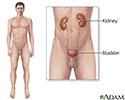Minimal change disease
Minimal change nephrotic syndrome; Nil disease; Lipoid nephrosis; Idiopathic nephrotic syndrome of childhood
Minimal change disease is a kidney disorder that can lead to nephrotic syndrome , although the kidney looks normal under a regular microscope.
Nephrotic syndrome
Nephrotic syndrome is a group of symptoms that include protein in the urine, low blood protein levels in the blood, high cholesterol levels, high tri...

Causes
Each kidney is made of more than a million units called nephrons, which filter blood and produce urine.
In minimal change disease, there is damage to the glomeruli. These are the tiny blood vessels inside the nephron where blood is filtered to make urine and waste is removed. The disease gets its name because this damage is not visible under a regular microscope. It can only be seen under a very powerful microscope called an electron microscope.
Minimal change disease is the most common cause of nephrotic syndrome in children. It is also seen in adults with nephrotic syndrome, but is less common.
Nephrotic syndrome
Nephrotic syndrome is a group of symptoms that include protein in the urine, low blood protein levels in the blood, high cholesterol levels, high tri...

The cause is unknown, but the disease may occur after or be related to:
- Allergic reactions
- Use of non-steroidal anti-inflammatory drugs (NSAIDs)
- Tumors
- Vaccinations (flu and pneumococcal, though rare)
- Viral infections
Symptoms
There may be symptoms of nephrotic syndrome, including:
- Foamy appearance of the urine
- Poor appetite
- Swelling (especially around the eyes, feet, and ankles, and in the abdomen)
- Weight gain (from fluid retention)
Minimal change disease does not reduce the amount of urine produced. It rarely progresses to kidney failure .
Kidney failure
Acute kidney failure is the rapid (less than 2 days) loss of your kidneys' ability to remove waste and help balance fluids and electrolytes in your b...

Exams and Tests
The doctor may not be able to see any signs of the disease, other than swelling. Blood and urine tests reveal signs of nephrotic syndrome, including:
- High cholesterol
- High levels of protein in the urine
- Low levels of albumin in the blood
A kidney biopsy and examination of the tissue with an electron microscope can show signs of minimal change disease.
Kidney biopsy
A kidney biopsy is the removal of a small piece of kidney tissue for examination.

Treatment
Medicines called corticosteroids can cure minimal change disease in most children. Some children may need to stay on steroids to keep the disease from returning.
In adults, steroids are effective, but less so than in children. Adults may have more frequent relapses and become dependent on steroids.
If steroids are not effective, the health care provider will likely suggest other medicines.
Swelling may be treated with:
- ACE inhibitor medicines
- Blood pressure control
- Diuretics (water pills)
You may also be told to reduce the amount of salt in your diet.
Outlook (Prognosis)
Children usually respond better to corticosteroids than adults. Children often respond within the first month.
A relapse can occur. The condition may improve after long-term treatment with corticosteroids and medicines that suppress the immune system (immunosuppressive medicines).
When to Contact a Medical Professional
Call for an appointment with your provider if:
- You develop symptoms of minimal change disease
- You have this disorder and your symptoms get worse
- You develop new symptoms, including side effects from the medicines used to treat the disorder
References
Appel GB, Radhakrishnan. Glomerular disorders and nephrotic syndromes. In: Goldman L, Schafer AI, eds. Goldman's Cecil Medicine . 25th ed. Philadelphia, PA: Elsevier Saunders; 2016:chap 121.
Mason PD, Hoyer PF. Minimal change nephrotic syndrome. In: Johnson RJ, Feehally J, Floege J, eds. Comprehensive Clinical Nephrology . 5th ed. Philadelphia, PA: Elsevier Saunders; 2015:chap 17.
Pais P, Avner ED. Nephrotic syndrome. In: Kliegman RM, Stanton BF, St Geme JW III, Schor NF, eds. Nelson Textbook of Pediatrics . 20th ed. Philadelphia, PA: Elsevier; 2016:chap 527.
Review Date: 9/22/2015
Reviewed By: Charles Silberberg, DO, private practice specializing in nephrology, affiliated with New York Medical College, Division of Nephrology, Valhalla, NY. Review provided by VeriMed Healthcare Network. Also reviewed by David Zieve, MD, MHA, Isla Ogilvie, PhD, and the A.D.A.M. Editorial team.

